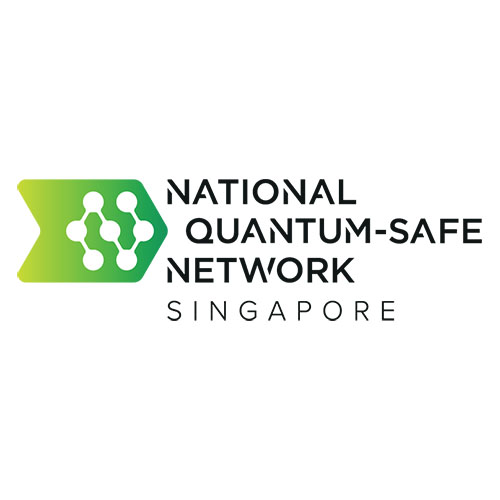Highlights
Singapore data centres exchange quantum-safe encrypted files
 An illustration of the inside of a data centre. Credit: Sashkin/Shutterstock.com
An illustration of the inside of a data centre. Credit: Sashkin/Shutterstock.com
Two data centres in Singapore were successfully connected with a quantum-secured link, the National Quantum-Safe Network (NQSN) and its collaborator ST Telemedia Global Data Centres (STT GDC) have announced.
The team are making public details of a trial carried out in 2022 as they embark on a second phase to explore new use cases.
“We appreciate the continued commitment of partners like ST Telemedia Global Data Centres, who are leading by example towards new standards of data security for Singapore’s infocomm sector,” says Alexander Ling, lead Principal Investigator for the NQSN. Alexander is also a CQT Principal Investigator.
The NQSN was launched in early 2022 as a nationwide testbed for quantum-key distribution (QKD) and post-quantum cryptography – methods to secure communication that should be resistant to future advances in computing power. Supported by Singapore’s Quantum Engineering Programme, the project is led from local universities with participation by government agencies and private companies. Find the full list of partners at www.nqsn.sg.
The NQSN team comes from CQT and the Department of Electrical & Computer Engineering (ECE) at the National University of Singapore (NUS), and the Fraunhofer Singapore Research Centre at Nanyang Technological University Singapore. The NQSN team worked with the STT GDC’s management team and engineers to plan and deploy a QKD trial, aiming to show the technology is feasible for a typical commercial data-centre environment. The proof of concept ran over production-grade optical fibre from NetLink Trust and used equipment provided by ID Quantique, a global leader in cybersecurity. The link achieved a key rate approaching 3 kb per second.
"We are delighted with the successful completion of Phase 1 of the Proof of Concept (PoC) between CQT and STT GDC. This milestone marks a significant achievement in the deployment of Quantum Key Distribution networks (QKDN) in Singapore, as it demonstrates the feasibility of establishing a quantum-secured link over current-day production-grade fiber. The successful integration of QKD technology into a real-world data centre environment opens up new possibilities for secure and resilient communication networks for mission critical data centre users. We look forward to further collaboration in the next phase of the PoC," said Daniel Pointon, Group CTO, STT GDC.
Key contributions
As part of the trial, NetLink Trust first studied the fibre connectivity parameters (such as the distance and theoretical loss) among STT GDC’s data centres to identify suitable trial locations. The two shortlisted locations were connected by fibres compliant with ITU-T G652.D & G.657A standards – similar to a typical fibre installed to Singapore homes. NetLink Trust patched through the connections, with NQSN-ECE supporting the last mile connectivity.
The final measured fibre link loss is about 13dB of loss, which is within the capability of the QKD systems. ID Quantique provided the QKD device Cerberis XGR for this proof of concept demonstration, a production-grade device that is already available on the market. It consists of a QKD transmitter and a QKD receiver, which establish a shared symmetric key between the pair.
The NQSN team commissioned the QKD devices at an NQSN node in ECE, NUS and then deployed the full QKD systems, including not only the QKD devices but also the control and management equipment (e.g. servers, routers, mobile network connectivity), to the two shortlisted data centres. The connection for the quantum channel was over the fibre link and a classical channel was established over a 4G/5G network.
After the QKD systems and QKD link setup, the team also successfully monitored the QKD system’s stability and performance. The actual key rate obtained was approaching 3 kbps. The standard deviation was about 4%, indicating good stability over the evaluation period for the testing environment. The team measured a quantum bit error rate of 1.9% which is relatively low. They further conducted an attenuation test to understand how the QKD equipment behaved over higher transmission losses.
Trial applications
To show how such technology can enable quantum-safe security, the QKD-keys were used with the Advanced Encryption Standard (AES) symmetric encryption scheme. The generated QKD keys were equivalent to a quantum-safe AES-256 key refresh rate of 11.45 pairs of keys per second – generating more than 8 million total AES-256 keys over the trial.
The team demonstrated file transfers between the two STT GDC data centres via a software-based virtual private network (VPN) tunnel encrypted with generated QKD keys and AES encryption, The VPN protocol was developed by Fraunhofer Singapore Research Centre at Nanyang Technological University Singapore.
The NQSN team has also facilitated a PoC involving the AWS Center for Quantum Networking, Horizon Quantum Computing and Fortinet that was reported in March 2023.
In working with its partners, the NQSN team aims to explore relevant use cases. As next steps with STT GDC, the team are discussing how to include additional sites together with technology and protocols emerging from other research and development projects supported by QEP.









